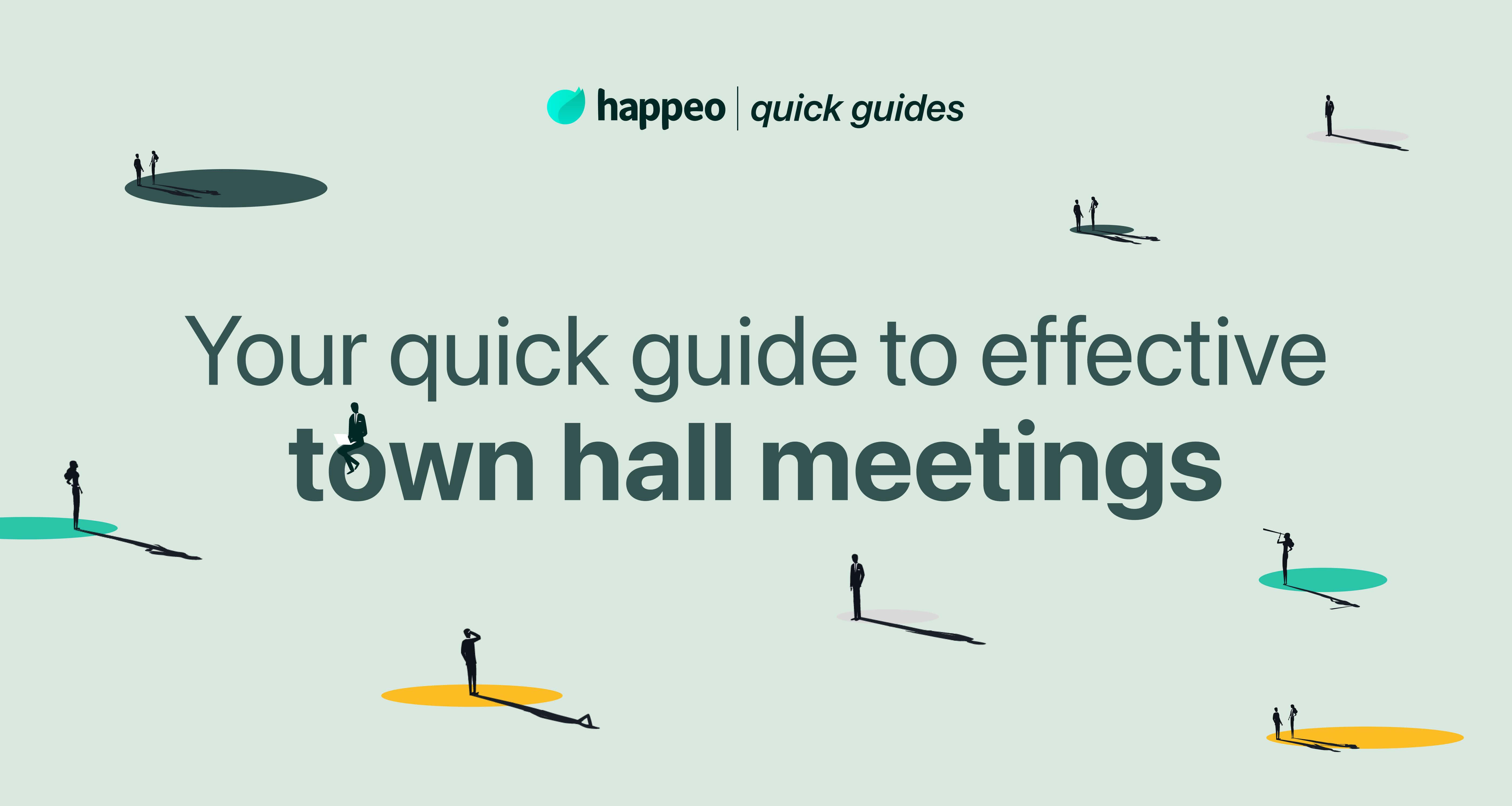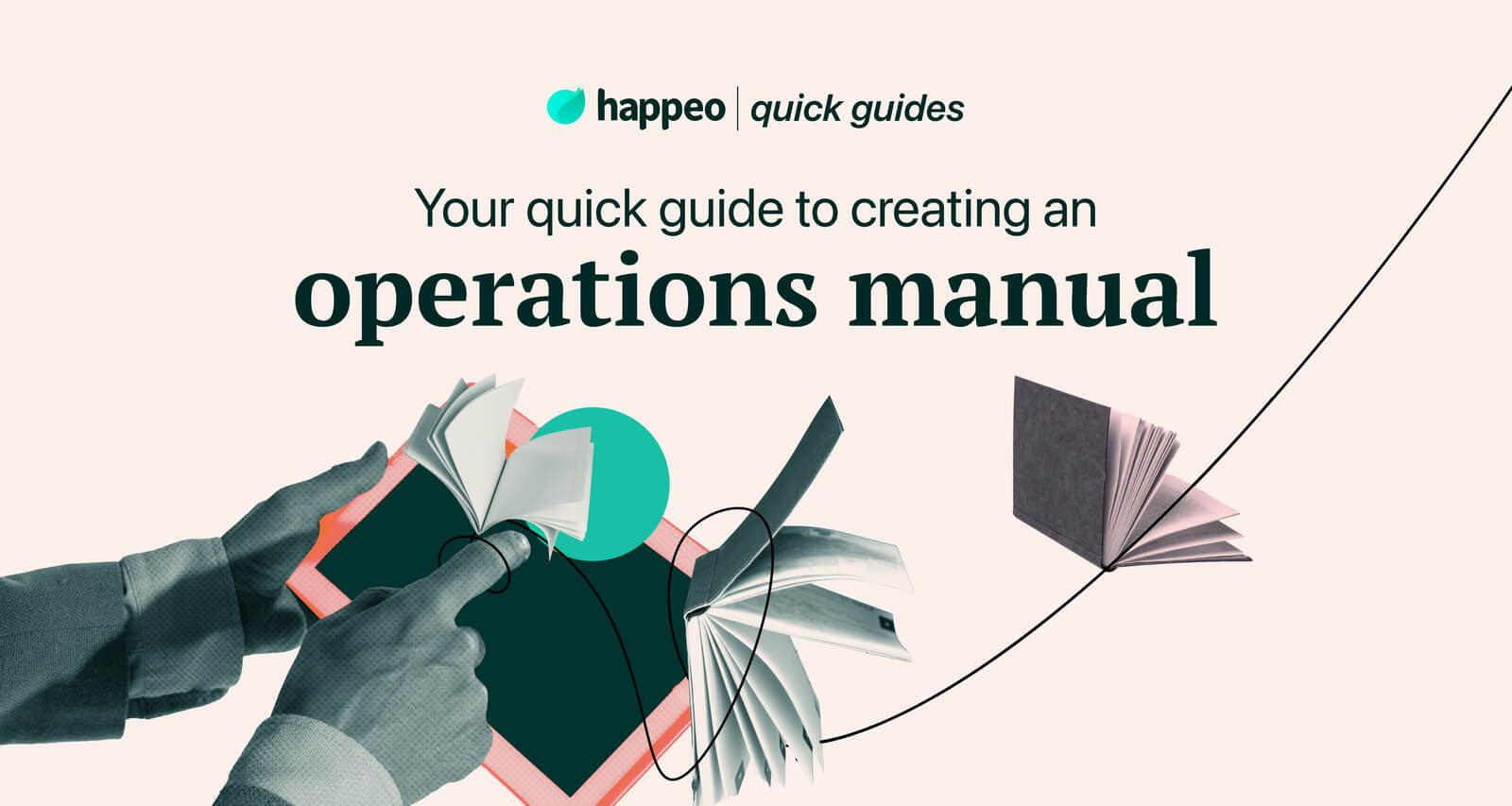
Quick guides
Your quick guide to effective town hall meetings (Incl. Template)

8 mins read
Start building your digital home with Happeo
Request a demoQuick guides
Product
Features
Solutions
Happeo for
Use cases
Resources
Explore
Support
Happeo For
Use cases
Comparisons
Explore
Support
Recent

Jonathan Davies
8 mins read
A town hall meeting is a regular event that involves all of an organization’s employees. They allow employees to learn about any new initiatives the company is launching, and discuss any challenges it’s facing. They’re also a chance for employees of all seniority levels to ask questions and provide feedback to the company’s leadership team.
When it’s done right, a town hall meeting shouldn’t be a long, dry presentation that employees are forced to sit through. It should be an engaging, two-way conversation that provides value to both leaders and employees.
Here are some of the benefits of hosting regular town hall meetings:
In the past, a town hall meeting was usually an in-person event that took place at the company HQ. But the changes to work patterns we’ve seen over the past few years mean that virtual town hall meetings are now very common.
It’s perfectly possible to host a town hall meeting on a platform like Google Meet or Microsoft Teams, and there are even some advantages to doing it this way. First, it allows all employees to attend the meeting, wherever they’re based. This means it’s often the only way to have a town hall meeting that involves everyone if you’re a distributed or remote organization.
Holding your town hall meeting online also makes it easier to record the meeting for people that can’t attend. They’ll be able to catch up later and experience the event in almost the same way as those who attended live. This levels the playing field for employees who live in different time zones or have different working hours.
Here are the steps to follow if you want to host your first town hall meeting (or make your town hall meetings more effective):
Before you get to the actual content of your meeting, you need to decide on the platform you’ll use to host it. You should also think carefully about the time you host your meeting, especially if you have employees in different time zones. If you can’t find a time that works for everyone, go for the time that works for most, and ask other employees to watch the meeting recording within the next working day. This gets everyone on the same page as soon as possible.
This is also the moment to build the team that will help run the meeting on the day. You’ll need to choose a host or MC, a variety of speakers, and a moderator to make sure everything runs smoothly. It’s also a good idea to have someone on hand for tech support in case something goes wrong.
Every town hall meeting should have a specific objective. This might be:
There are also other, softer reasons for hosting a town hall meeting, like building trust and improving employee morale.
Next, plan the agenda for the meeting, including the timings for each section. During the meeting, it’s important to be fairly strict with timings to ensure you keep your audience’s attention. That said, you should account for at least a little extra time in case you run over, particularly for the Q&A session.
The next step is to help your presenters to prepare their slide decks and talking points. It’s a good idea to use simple slides with just a few words per slide. This way, presenters can move through them quickly and keep everyone’s attention.
You should also have each presenter run through their presentation before the meeting to make sure it’s not too long. If they run over, work with them to find a more concise way of saying what they want to say.
Let your employees know about the town hall meeting as early as possible so they have plenty of time to clear their calendars. As well as the time, date and location of the event, you should include the meeting agenda so employees know what to expect.
You should also tell them about any rules you’ll have in place to make sure the meeting runs smoothly, such as asking employees to mute their mics when they’re not speaking.
Town hall meetings usually end with a Q&A session, which gives employees an opportunity to ask questions about the things you’ve discussed. But you should also provide a space for employees to ask questions before the meeting.
This allows those who aren’t able to attend to contribute and get answers to their questions. Also, if certain questions come up multiple times, you could use this to inform your agenda for the meeting. After all, if a few employees are asking the same questions, there’s a good chance others are thinking about them too.
Arrange to meet with your team for a technical dry run around 30 minutes before the meeting starts. This involves running through presentations, checking that everyone’s mics work, and testing any apps or platforms you plan to use.
Town hall meetings usually begin with a greeting from the CEO and/or the meeting host. Some organizations ask a different employee to host the meeting each time, which can give it a more informal feel.
If possible, it’s great to welcome each participant by name as they join the meeting. You might also want to include a short icebreaker activity to help warm things up — like asking everyone a funny question and having them discuss it in groups.
Watching someone present for a long time can be tiring for employees. And you might begin to lose their attention if you don’t build in opportunities for participation. Quick activities like surveys and polls can help break things up — as well as giving you useful insights into what your employees are thinking.
Most video conferencing tools, including Zoom, Google Meet and MS Teams, include in-built poll features that can help you conduct a virtual “show of hands” to keep people engaged. And you could even introduce elements of gamification by using an app like Kahoot to quiz your audience on the things you’ve just talked about.
The Q&A section is one of the most important parts of a town hall meeting. To make it as effective as possible, encourage your audience to send in questions as they think of them during the meeting. It’s usually easiest if your event moderator collates the questions in a document as they come in, and then reads them to the presenters one by one during the Q&A session.
It’s also important to prepare your presenters ahead of time for any difficult or sensitive questions that might come up. Presenters should feel comfortable saying that they don’t have an answer to a question. However, they should promise to answer the question at a later date, and let the employee know when this will be.
After the event, send the recording with a short recap to everyone that was invited. This gives those who couldn’t attend the chance to catch up, and provides a useful refresher to everyone else. You could send this out in a simple email, but you might also want to put a more detailed recap on a dedicated intranet page.
At this stage, it’s also a good idea to ask employees that attended the meeting for feedback. Asking simple, open-ended questions like “what did you enjoy?” and “what could have been better?” can help you improve in time for your next town hall meeting.
With Happeo’s Page Templates, it’s never been easier to prepare for a town hall meeting. You can create a page with all the details your employees need (including the time, date and link to the virtual meeting) in just a few minutes.
Then, you can easily add details about the hosts so that employees can find out about them ahead of time, and include the agenda for the meeting so everyone knows what to expect. You can even provide a space for employees to ask their pre-meeting questions right within Happeo — so there’s no searching around for the right person to email.
After the event, you can post a recap, recording and survey link on the same page, so everyone knows where to find them.
Start a free trial to play around with Happeo’s town hall meeting template.
